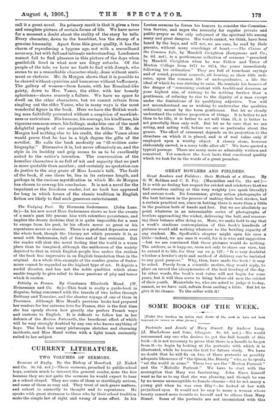SOME BOOKS OF THE WEEK.
[Under this heading we tidies such Books of the week as have not been reserved for roviem in other forms.] Portraits anti Jewels of Mary Stuart. By Andrew Lang. (J. MacLehose and Sons, Glasgow. 8s. Gd. net.)—We would recommend any one who desires to get the full benefit c,f this book—it is not necessary to prove that there is a benefit to be got from it—to begin by looking at the portraits with which it is illustrated, while he leaves the text for future study. We have no doubt that he will fix on two of these portraits as possibly adequate likenesses of "the Queen, the Beauty" who, so to speak, "set the world in arms." These two are the "Morton Portrait" and the "Melville Portrait." We have to start with the assumption that Mary was fascinating. John Knox himself went as far as to say that she was pleasing, and though he was by no means unsusceptible to female charms —did he not marry a young girl when he was over fifty ?—ho looked at her with prejudiced eyes. It would not be easy to name a woman whose beauty caused more trouble to herself and to others than Mary Stuart. Some of the portraits are not inconsistent with this condition, though they do not suggest it; others may be said to snake it extremely unlikely, if not impossible. The Morton picture Shows a stately woman, beautiful certainly, and quite possibly fascinating, but painted from what we might describe as a different point of view. It looks like a " State portrait" of a very noble type, reconciling the charm with the dignity,—" a human face and the face of a Queen who looked her part," as Mr. Andrew Lang puts it. It has been travestied, though cleverly travestied, by two well-known reproductions. But the " Melville Portrait" actually gives the fascination. This is a quality of face which it is one of the artist's greatest difficulties to render adequately, so hard is it to be neither insipid nor vulgar. But it is here. There are adverse considerations, it is true. One of them is that technical reasons put the date later than suits the evident youth of the subject. But then it may be a good copy, with some changes, not very important after all. On the .other hand, the argument from the jewels, which are represented here as those which Mary is known to have possessed, strongly supports the identification. On the whole, we agree with Mr. Lang that when we look at this picture "we know what the Queen was like in her youth and her witchery." We cannot follow Mr. Lang in his very acute and painstaking account of the other pictures. It is a subject after his own heart, and he has done it ample justice.







































 Previous page
Previous page